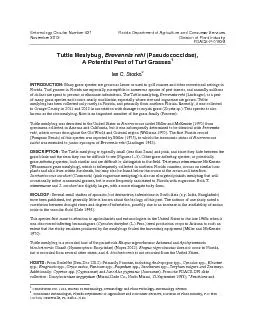

Tuttle Mealybug INTRODUCTION Many grass species are grown as lawns or used in golf courses and other recreational settings in Florida Turf grasses in Florida are especially susceptible Contributi ID: 823578
Download Pdf The PPT/PDF document "Entomology Circular Number 421 Florida..." is the property of its rightful owner. Permission is granted to download and print the materials on this web site for personal, non-commercial use only, and to display it on your personal computer provided you do not modify the materials and that you retain all copyright notices contained in the materials. By downloading content from our website, you accept the terms of this agreement.
Entomology Circular Number 421 Florida
Entomology Circular Number 421 Florida Department of Agriculture and Consumer Services November 2012 Division of Plant Industry FDACS-P-01829 Tuttle Mealybug, INTRODUCTION: Many grass species are grown as lawns or used in golf courses and other recreational settings in Florida. Turf grasses in Florida are especially susceptible Contribution No. 1223, Bureau of Entomology, Nematology and Plant PathologyEntomology Section of Agriculture and Consumer Services, Division of Plant Industry, P.O Box 147100, Gainesville, FL 32614-7100Dactyloctenium (Palm Beach Co., Lake Worth, 3 October 1977); Eleusine indica (Palm Beach Co., Delray Beach, 28 October 1982); Ptychosperma sp. (Miami-Dade Co., Miami, 16 October 2002); Cynodon dactylon (Hillsborough Co., Sun City, 27 July 2007); and Zoysia sp. (Orange Co., 14 August 2012). DISTRIBUTION:Officially recorded in the United States only from Arizona, California, Florida and Texas (Ben-Dov 2012), but is probably more widespread in southeastern states that produce turf grasses for the sod market. Tuttle mealybug is known from other regions of the world (., Palearctic regionAfghanistan, Iraq, Iran; Ben-Dov 2012) where there is a distinct cold season, which suggests the mealybug may be capable of surviving throughout much of the United States. ECONO
MIC IMPORTANCE: Since Bermuda and zoysia
MIC IMPORTANCE: Since Bermuda and zoysia are important lawn grasses, especially in the southern United States, infestation by Tuttle mealybug should be considered whenever dieback is noticed, especially if the grass blades show white wax or are sticky from honeydew secretion. Both Bermuda and zoysia lawns are commonly installed as sod or plugs, which provide a ready route for the spread of infestations should the pest control practices of the grower fail to maintain a pest-free production environment. Additional collections are needed to establish whether populations of the Tuttle mealybug in the United States have any predators or parasitoids that control them naturally. Since many other mealybugs can also be found on grass, it is necessary to slide-mount specimens for identification. If die-back in lawns is noticed, examine the blades closely for possible mealybug pests (Figure 4) and submit a sample to your county extension agent for further analysis. LITERATURE CITED Ben-Dov, Y. 2012. ScaleNet. http://www.sel.barc.usda.gov/catalogs/Pseudoco/Brevenniarehi.htm#Brevenniarehi. (Last accessed 5 September 2012.) Dale, D. 1994. Insect pests of the rice planttheir biology and ecology. Pp. 363486. In: E.A. Heinrichs (ed.) Biology and management of rice insects. Wiley Eastern Limited, New Age
International Limited, Bangalore, India
International Limited, Bangalore, India. Miller, D.R. and H.L. McKenzie. 1970. Review of the genus Heterococcus (Homoptera: Coccoidea: Pseudococcidae) with a description of a new species. Annals of the Entomological Society of America 63(2): 438453. Miller, D.R. 1975. A revision of the genus Heterococcus Ferris with a diagnosis of the genus Brevennia Goux (Homoptera: Coccoidea: Pseudococcidae). United States Department of Agriculture Technical Bulletin 1497: 161. Noyes, J.S. 2012. Universal Chalcidoidea Database. World Wide Web electronic publication. http://www.nhm.ac.uk/chalcidoids. (Last accessed 5 September 2012.) Williams, D.J. 1970. The mealybugs (Homoptera, Coccoidea, Pseudococcidae) of sugar-cane, rice and sorghum. Bulletin of Entomological Research 60: 109188. Close-up of Tuttle mealybug, Brevennia rehi, on a stem of zoysia grass. Photography credit: Lyle Buss, Univ. Population of adult and immature Tuttle mealybugs, Brevennia rehi, on a blade of zoysia grass. Photography credit: Lyle Buss, University of Florida. Wax residue of population of Tuttle mealybugs, Brevennia rehi, on blades of zoysia grass. Photography credit: Lyle Buss, University of Florida. Dieback in zoysia grass due to Tuttle mealybugs, Brevennia rehi. Photography credit: Roi Levin, Environmental Pest and La